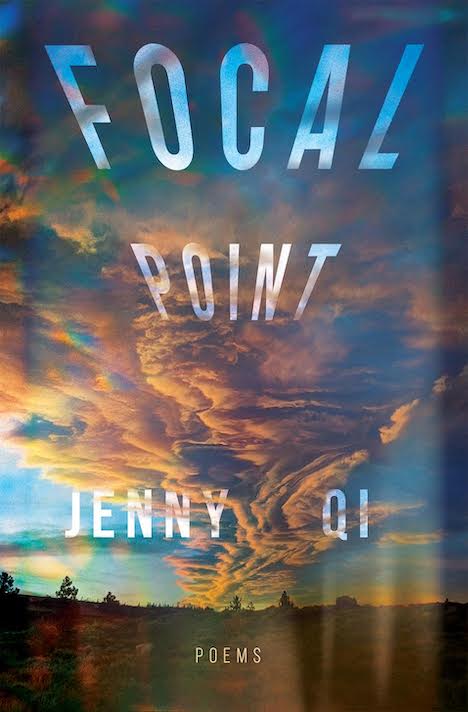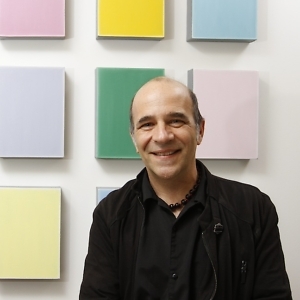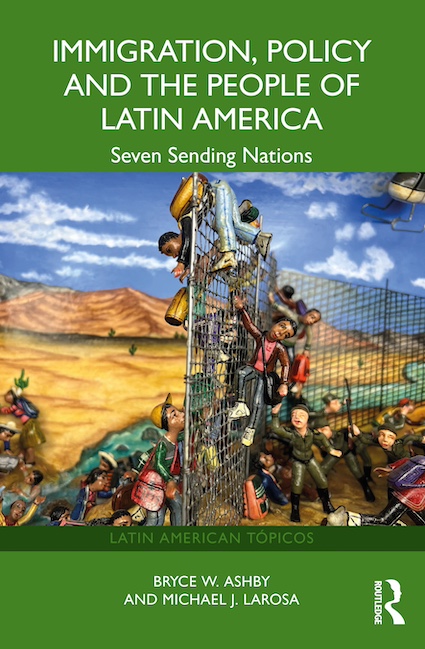Found in Translation
Jennifer Uman discovered the story for her first children’s book through a language she doesn’t speak
While many illustrated children’s books are collaborative efforts, few involve an international partnership quite like the one that resulted in Jemmy Button, a beautiful new work by Nashville-based illustrator Jennifer Uman and Italian illustrator Valerio Vidali. Their creation, based on a fascinating true story from the annals of Victorian-era exploration and colonialism, looks at the ways in which linguistic and cultural boundaries and identities can—and can’t—be breached or dismantled. But it also tells a story of estrangement, homesickness, and a journey across the sea that should engage young children and adult readers alike.
Jemmy Button was a real boy, Orundellico, who was taken from his homeland of Tierra del Fuego by British explorers in the early-nineteenth century. His captors, plotting an experiment in Christian and European cultural indoctrination, offered the boy’s family a pearl button in exchange for permission to take him on an extended sojourn to London. In England, “Jemmy Button,” as he was known, became a curiosity worthy of the attention of the queen.
Uman and Vidali tell Jemmy’s story through masterful use of color and scale. On the cover, Jemmy is seen peeking through a parting in a mass of tall grasses, visible only as a tuft of black hair atop a tiny pie-slice of face. Throughout the book’s series of full spreads, he is but a tiny figure in the expanse of his surroundings, be it a thick forest or crowds of silhouetted Londoners in formal Victorian attire. The effect aptly suggests a sense of bewilderment and loneliness in an alien culture. When at last it is agreed that Jemmy “should go back and teach his people what he learned,” the reader anticipates what does in fact transpire: back in his homeland, Jemmy soon casts off the trappings of his Western education—both the finery and the English nickname.
Uman and Vidali first began corresponding online. Neither spoke the other’s language as they worked on the book, both remotely and side by side in Uman’s apartment, over the span of several years. The result is what Publishers Weekly called “a snapshot of colonial betrayal [that] evokes regret, longing, guilt, and awe.” Uman recently answered questions from Chapter 16 via email about the unusual process behind the making of the book.
Chapter 16: Given the language barrier, how did you strike up a friendship with Vidali online?
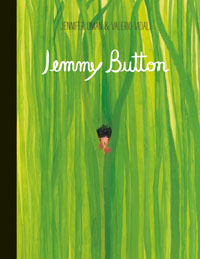 Uman: I emailed him as a big fan of his work. He responded very quickly with gratitude, in broken English. I had seen a video posted on his blog of his pet bird, Marcello: a real bird who was lost and followed Valerio home, and they became buddies. I thought it was sweet and told him so in my first email to him. He thought that was awesome because no one ever had ever commented on that before. So it was Marcello who gave us the platform to strike up a friendship.
Uman: I emailed him as a big fan of his work. He responded very quickly with gratitude, in broken English. I had seen a video posted on his blog of his pet bird, Marcello: a real bird who was lost and followed Valerio home, and they became buddies. I thought it was sweet and told him so in my first email to him. He thought that was awesome because no one ever had ever commented on that before. So it was Marcello who gave us the platform to strike up a friendship.
Chapter 16: You communicated with Vidali with the help of an online translator. What surprises did this process hold?
Uman: When we first started emailing each other we would write in both English and Italian. The translations were never correct, and the more context [we provided] the worse the results were, often incomprehensible but hilarious. So we created our own way of corresponding. It took us a while to figure out that by rearranging pronouns and adjectives the translations would come across more directly and simply. Or so we thought. My dearest friend, who is Italian, was visiting once, and I showed her an email to see if she could help me understand Valerio’s voice. She said it was almost impossible to read in Italian because it made no sense. But the translations were great. So we kept emailing in this backwards way that worked.
Chapter 16: What did you see in Vidali’s work and sensibility that made you want to collaborate with him on a book, and vice versa?
Uman: Valerio has a tenderness in his precision, and he does not rest on literal interpretations in his work. It was the opposite of how I work, and it pulled me in. He is well schooled in materials and uses them all. I am not and have grown to love the materials I can afford. I would like to believe that was the sensibility he was attracted to. Our differences seem to be what spurred our collaboration.
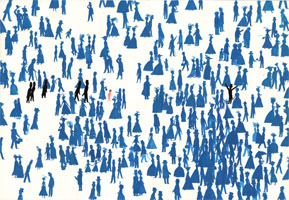 Chapter 16: What attracted the two of you to the story of Jemmy Button? It seems especially well-suited to your circumstances: the story of a boy who cannot communicate with those around him, told by two artists whose communication is challenged by the barriers of both distance and language.
Chapter 16: What attracted the two of you to the story of Jemmy Button? It seems especially well-suited to your circumstances: the story of a boy who cannot communicate with those around him, told by two artists whose communication is challenged by the barriers of both distance and language.
Uman: Jemmy Button was a reference Valerio made when I asked him what he imagined New York to be like. He had never been to the United States before we met. I did not understand the Jemmy Button reference but looked it up, and it was impressive. Honestly, not until I had the book in my hands and could completely disconnect from the process and read it front to back did I realize how much of our story is echoed in that of Jemmy.
Chapter 16: Tell us how this international collaboration worked. Did you follow a regular process for the completion of each drawing?
Uman: I was living in New York the entire time Valerio and I worked together. Valerio would fly in on the cheapest flights and rent a place for a few months, living on pasta and soup. We were really lucky to have amazing friends who opened up their homes and let him stay, which helped us see this project through. He’d show up at my door each morning with bodega coffee, and we’d work until the sun went down every day. We worked side by side at my kitchen table. Each time he came to New York we picked up where we left off, though not always with the same momentum or at the same time of year. I feel lucky we got to work through every season. The light was different, as was the food we ate and everything around us. It was summer when we began working together, and we ended Jemmy a few winters later. Not long after the book was complete I moved to Nashville. It was hard leaving the apartment where Jemmy was made, but we were happy to hand over the keys to some pretty great people.
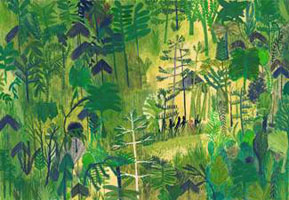 Chapter 16: The book’s text was written by a third collaborator, Alix Barzelay. Did the words come only after the illustrations were complete, or at some other point in the process?
Chapter 16: The book’s text was written by a third collaborator, Alix Barzelay. Did the words come only after the illustrations were complete, or at some other point in the process?
Uman: Alix Barzelay is an extraordinary writer whom I have known for a very long time. She and I talk a lot about nothing and everything, as friends often do. She was a part of this book before it began and knew every step of my and Valerio’s process. When we invited her to contribute to our work, there was so little explaining to do. She came in with the words after the illustrations were complete and did so instinctively and smoothly.
Chapter 16: It’s interesting that Barzelay isn’t cited on the book’s spine as the author. Does that omission suggest there’s something different about the relationship between text and images in this book?
Uman: Working on this project for years with Valerio led us into a partnership and agreement that this book was and is conceptually and visually ours. When Alix joined our project she gave new life to our images; however, at that point our publisher was capable of allowing us to use Alix’s words but [only] as a work-for-hire contractor. It is not common practice to be publicly credited for the work anywhere on the book if commissioned without copyrights, [but] we fought for her name to be on the cover and/or spine. Although it didn’t happen we were very happy we got her name on the cover page.
Chapter 16: Do you have plans to collaborate with Vidali again, or to work on another illustrated book? Any plans to meet again in person?
Uman:Valerio and I would be happy to work together again but for now our lives do not have the flexibility they did when our project first began. We are forever friends in ways that cannot be filled by any other people on the planet. Alix Barzelay and I have just confirmed we are working on a new book together. Her writing is clear and visual, any artist’s dream to interpret. Alix and I live a few miles away from each other in Nashville, and as much as I miss Valerio it is nice to have a partner who lives a car ride away.
Chapter 16: Can you tell us a little bit about your new book with Alix?
Uman: We are in the early stages of storyboarding and sorting through some rare and specific references, so I am not ready to say too much, but the story is complete. When I first read it I was taken exactly to the place she created. It is incredible to work with someone who can transport you with clear construction of beautiful words. It is royal, relatable, and a story so many families in the world are going to be happy exists.



